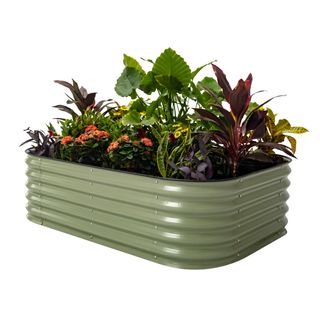There are many good reasons to plant in raised beds. One of the most important is that they drain better than most standard beds. The raised design helps to minimize standing water, and the ability to control the quality and content of the soil means you can create the perfect mix for good drainage. While raised beds have good drainage, certain steps can be taken to improve it even further.
Why do raised garden beds need drainage?
Wherever you plant your plants, they need good drainage. The exception, of course, is plants that grow in swamps or water. Most plants need well-drained soil. Standing water around their roots will suffocate them by depriving them of oxygen. Soggy soil and standing water also put plants at risk of rot and disease.
Raised bed drainage is already an improvement over standard in-ground beds. You can still improve it with the right choices. This is important because even with good elevation and soil mix for raised beds, drainage may not be good enough.
How to Increase Drainage in Raised Garden Beds
There are a few things you can do during the construction and planting of raised beds to maximize drainage:
1. Choose the right location
Before you begin, choose the best location for your raised beds. Avoid low areas of the garden that tend to collect water. Observe what happens after a heavy rain to find areas that tend to drain well and not have standing water. Balance the need for drainage with a location that gets plenty of sunlight.

17″ Tall 6-in-1 Modular Metal Raised Garden Bed Kit
The Vego 6-in-1 Tall Planter can fit into small, hard-to-fill garden spaces.
2. Create the perfect soil mix
Next, create good soil. Soil is one of the biggest factors in drainage. You can buy bags of good quality garden soil or potting mix to use in your raised beds. Or, if you have extra soil in your garden, you can add materials to it to create a good mix. Mix compost into the soil and add something that will improve drainage, such as perlite, vermiculite, or peat moss.
3. Add layer
Just using a good soil mix will help your bed drain well, but adding more layers of soil can improve this even more. Place some loose organic material at the bottom of the bed. This could be twigs and leaves, wood chips, or even grass clippings. This will fill in some of the space and allow for more drainage at the bottom.
Spread a layer of high-quality compost over the loose organic material. Finally, add about 12 inches (30 cm) of your ideal soil mix on top.

32″ Tall 10-in-1 Modular Metal Raised Garden Bed Kit
The Vego raised flower bed is up to 32 inches tall for ultimate accessibility.
4. Cut drainage holes
If you feel like your raised bed isn’t draining well, even with layers of organic material and good soil, poke holes in the sides of the bed. Drill or cut holes or slits along the sides so excess water can drain out the sides of the bed.
5. Create a slope
When building raised beds, create a gentle slope to allow water to drain out of the bed. The slope can be from one end to the other or from the middle of the bed outward. Aim for a 2% slope. This slope is about a quarter inch (0.6 cm) for every foot (30 cm) of distance.
6. Maintain your raised beds
Once you have created a raised bed with excellent drainage, you can focus on maintenance. Occasionally aerate the soil to provide more oxygen to the roots and prevent soil compaction, which can reduce drainage.
Wooden beds are a popular choice, but they will rot over time. If you don’t want to replace the wooden planks with new ones, consider

9 in 1 Modular Metal Raised Garden Bed Kit 17″ Tall
Vego raised flower beds have a lifespan of over 20 years and will always look beautiful over time.
This article introduces products available from third-party vendors on Gardening Guide Store.
